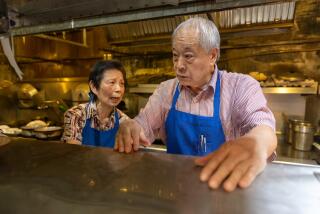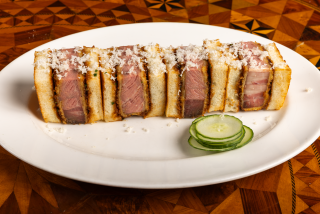Boston’s Historic Pub
- Share via
BOSTON — If tradition is the soul of Boston, as they say, then I invite you to one of the places on which the city’s reputation rests. We will turn right on downtown Winter Street and follow the little dead-end alley to the last brick building on the left.
Inside the building--just a stone’s throw from where the patriot Samuel Adams lived after the British army requisitioned his waterfront home--is the Locke-Ober Cafe. As far as the civilized art of serving hearty food and honest drink goes, Boston’s history starts here.
Locke-Ober’s has been an institution in Boston for 112 years, and if its dark-paneled walls could only speak, what secrets we would learn.
This is where Enrico Caruso always insisted on the sweetbreads, where Ogden Nash composed a poem to the martini--which he always ordered two at a time, straight up, where John F. Kennedy’s favorite luncheon was lobster stew followed by a steak. (JFK’s grandfather, “Honey Fitz” Fitzgerald, was a regular, too.) For Jack Benny, Boston wouldn’t have been Boston without a visit to Locke-Ober’s for lobster savannah and man-sized martinis.
A Tradition Ends
Until 1970, women were only allowed into the saloon-styled, ground-floor dining room on two occasions a year--New Year’s Eve and the evening of the annual Harvard-Yale football game. That tradition crumbled quietly one noon when a party of eight, booked in the name of a Dr. Remington, all turned out to be women, and the head waiter wisely decided to go along with the gag without making a fuss.
But though the restaurant was liberated under the eyes of the Victorian nude, Mademoiselle Yvonne, who adorns the far wall with raised goblet in hand, surprisingly little else has changed since Louis Ober, a French-born entrepreneur, and Frank Locke, a New Hampshire saloon-keeper, joined forces a century ago.
A dumbwaiter, installed in 1886, still ferries drinks from the downstairs bar to the second-floor Ober Room, where the wall paneling, fitted together without nails, once graced the library of the John Astor estate in Newport, R.I.
Silver tureen and platter covers from Germany sparkle behind the mahogany, L-shaped luncheon counter, as they have longer than anyone can remember, and Caruso’s favorite sweetbreads are still on the menu (at $19.75). Customers returning to the restaurant after a long absence are often startled to be served by the same waiters they remember from 15 or 20 years earlier.
“Part of the mystique of Locke-Ober’s is that so much of the past has been maintained, so little has changed,” said Nathan Withington, one of three partner-owners. “If we try to make any alterations, the roof caves in with complaints.”
Raising a Ruckus
Locke-Ober’s loyalists, in fact, raised such a ruckus when they heard the ancient and chipped Italian mosaic-tiled floor in the downstairs saloon was going to be removed that the partners had to resort to subterfuge: They snuck a tasteful new carpet into the restaurant on a Sunday morning, and by the time customers arrived for Monday lunch, there wasn’t a tile in sight.
Outside of an occasional ad in the Wall Street Journal for its private dining rooms, Locke-Ober’s prospers entirely by word-of-mouth and its high degree of repeat patrons, many of them “foreigners,” which in Boston means anyone not from New England.
That is testimony enough for the quality of its menu; specialties are New England seafood (Martha’s Vineyard bay scallops, $18.75), cuts of meat (filet mignon with potato Parisienne, $22.95) and memorable appetizers such as eggs fisherman for four at $9 (lettuce, fresh crab meat, boiled eggs, olives and tomatoes).
As the late Oscar Wilde once said: “After a good dinner, I can forgive anybody.” To that, Ogden Nash, midway between his two courses--martinis and boiled lobster--added: “Taking a trip to Boston without visiting Locke-Ober’s would be like going to Agra and ignoring the Taj Mahal.”
More to Read
Sign up for The Wild
We’ll help you find the best places to hike, bike and run, as well as the perfect silent spots for meditation and yoga.
You may occasionally receive promotional content from the Los Angeles Times.






